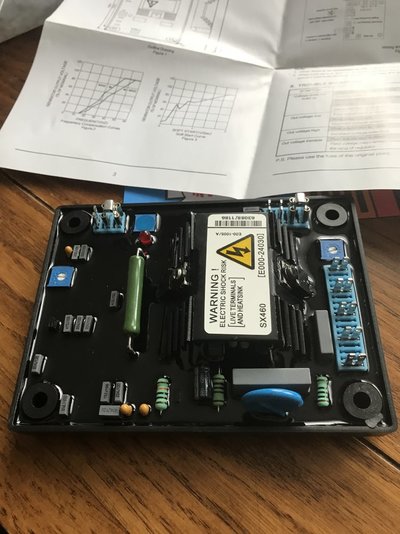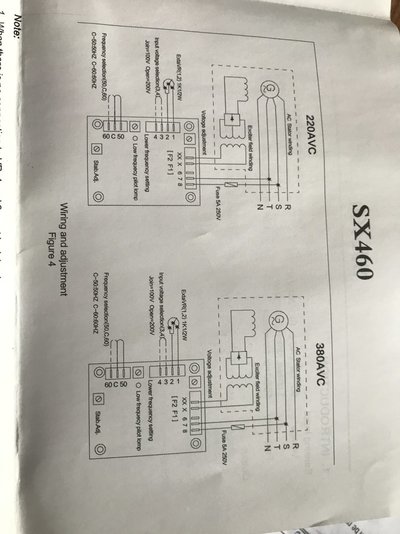Welderherup
Member
- Messages
- 62
- Location
- Lisburn
Forgot to confirm all connections are good
Ok great. So it be as simple as buying the above mentioned board and putting it straight on? Do you believe it is possible to repair the board I have?X & XX on these is exciter DC positive & negative.
It's vital that they ate connected the correct way around on any replacement AVR.
It's only 4-wire which is a basic shunt excited alternator (as you'd expect on a small older alternator - so it's quite likely that there are a number of AVRs that might do instead...
I'd need to be in work to try and find out.
As for Frequency yes you need to be at 50Hz, but with AVR Regulation the voltage should stay as set-up. Only capacitor controlled alternators have the AC voltage rise with increased revs & frequency.
At 300vac, it's most likely that the voltage control part of the AVR has failed - so a healthy AVR is most likely all you need.
That's a standard CMOS device - hex inverter buffer.The black chip has the number
MC14069UBCP
M 78-48
@Welderherup Do you believe it is possible to repair the board I have?
Great thanksFrom GRW's post above, SX460 is suitable.
Yes it’s so inexpensive that I can keep a spare. I will extend the wires and run it off to where there is spaceI'm not familiar with that exact alternator or AVR.... but it should work. The SX460 should have its terminals clearly marked, so hopefully you'll be able to connect it up no problem.
It's a good idea to turn the Volts potentiometer anti-clockwise to min. before starting up, and then turn it up slowly with a multimeter on the output to get to to the required ac output volts.
If the voltage comes up but fluctuates, then the STAB (stability) pot can be adjusted to tune it out (you want no more stability wound on than necessary - you want the AVR to be able to respond to load changes rapidly but with stable voltage).
At £14, it'll not be a genuine SX460, but at that price you can afford to replace it or keep a spare.
A "real" one would be a couple of hundred plus - we've used pattern ones but tend to get them from a good source and the cost rather more than £14.
An SX460 probably won't fit in the space the original lived btw. Bearing in mind it's got AC on its terminals you want it to be safe & secure. Easiest way is go extend the wires into a small plastic electrical box, and mount the box on top of the alternator top box lid
That shouldn't be an issue with a potted AVR like the SX460 - a lot of rental build gensets have the AVR located inside the control panel for ease and speed of access - and there's no adverse effects on the AVR'sIt may be cheaper because the SX460 has been superseded by the AS440 - or just a copy.
Bear in mind that the airflow through the generator will provide cooling to the AVR, locating it out of the airflow may lead to problems.
I know - they usually have louvred vents into the genset airflow and the power semiconductors are heatsink mounted proud of the potting, if the OP is planning on fitting in an insulated enclosure with no airflow, it may cause issues at high loadings. I thought it was worth pointing out. We had to modify some FGW gensets for operation at high altitude & ambient due to the location of the AVR's. The Mil 16/24 gensets threw all kind of issues if they were run with the acoustic covers up, even at UK temperatures.That shouldn't be an issue with a potted AVR like the SX460 - a lot of rental build gensets have the AVR located inside the control panel for ease and speed of access - and there's no adverse effects on the AVR's
Interesting. I only dealt with FGW's regular sets and their XD Rental stuff. Sure you get AVR's fail, but then they all do at some pointI know - they usually have louvred vents into the genset airflow and the power semiconductors are heatsink mounted proud of the potting, if the OP is planning on fitting in an insulated enclosure with no airflow, it may cause issues at high loadings. I thought it was worth pointing out. We had to modify some FGW gensets for operation at high altitude & ambient due to the location of the AVR's. The Mil 16/24 gensets threw all kind of issues if they were run with the acoustic covers up, even at UK temperatures.







